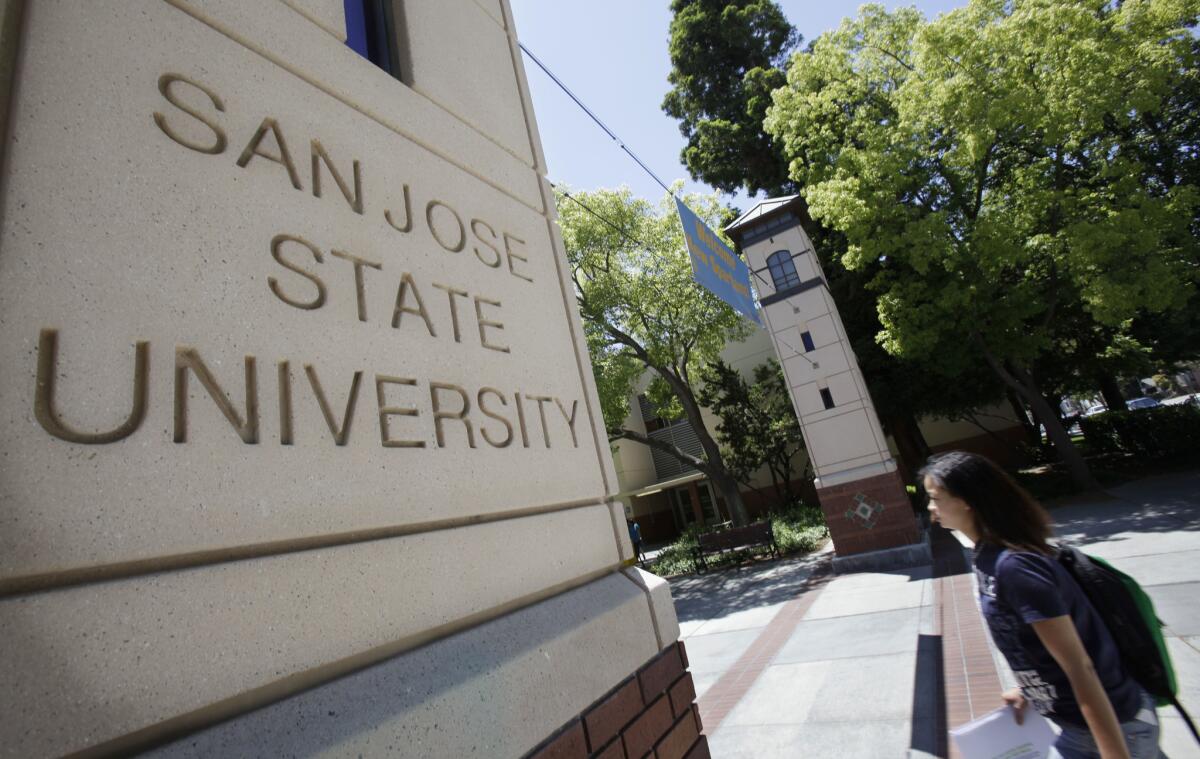Capitol Journal: California’s state universities are a path to mobility and tuition needs to be free

Reporting from Sacramento — The perfect place to see California’s changing face and our future is at a state university graduation ceremony.
It’s a multicolored demographic assortment of ambition and promise probably unequaled anywhere outside diverse California.
Much has changed at our public institutions of higher education since I graduated 60 years ago. Most importantly, there’s tuition now. More on that later.
When I attended San Jose State, the student body was overwhelmingly white. I’d guess 90%. We know it was 80% in 1969.
Today, San Jose State is only 17% white. It’s 42% Asian, 28% Latino and 3% African American. The main reason for the high Asian enrollment is that 37% of the population in Santa Clara County, where San Jose State is located, is Asian. And the largest contingent of foreign students is from Asia.
Overall, 42% of the 481,000 students at the 23-campus California State University system are Latino. The rest of enrollment includes 23% white, 16% Asian and 4% African American students.
“Our enrollment reflects the changing diversity of the state of California,” notes San Jose State President Mary Papazian, who grew up in the San Fernando Valley — Sherman Oaks, Northridge — and earned her bachelor’s, master’s and doctoral degrees all at UCLA.
UC will not raise tuition for California students this fall, Napolitano says »
The CSU system is serving a different demographic mix of students these days, but its core mission hasn’t changed over the decades. And that’s what struck me as I watched the commencement pageantry at San Jose State last week.
The state universities have always performed the essential role of lifting up the children of lower and middle socioeconomic groups to a higher level. Meanwhile, they’ve helped provide an educated workforce for an expanding California economy.
In my day, many of the students were the white kids of Depression-era Dust Bowl migrants.
My dad left the family farm in Tennessee to work in the booming California oil fields during the 1920s. About the same time, my mom abandoned what she considered a backward Oklahoma to seek a better life out here. Typical of California, they met at a beach party near Ventura.
Many of today’s students are from families of foreign immigrants who fled Latin America or Asia searching for opportunity. Some — mainly from Latin America — surely are here illegally, but university officials don’t keep tabs.
There’s another CSU function that has never changed: It’s a place where kids go who are the first of their families to attend college. That was me after two years at a community college. Today, roughly half of San Jose State’s attendees are first-generation college students.
“We are stewards of the American dream,” Papazian says. “Where you see socioeconomic mobility is at institutions like ours.
“Talent is everywhere,” she adds, “It’s opportunities that are not everywhere. That’s the power of CSU.”
Elizabeth Warren proposes canceling student loan debt and offering free public college »
It was a kick to watch the graduates bounding across the stage — broad smiles, gleaming eyes, many waving to proud family members, some clowning — to shake hands with Papazian and receive their diplomas. This was at the commencement for the College of Social Sciences at a Major League Soccer stadium. There were around 1,100 graduates.
One African American woman was especially inspirational. She walked on stage beaming with two young children. That was against the rules, but no one cared. You assumed she was showing her kids what all the sacrifice was about.
I had a front row seat because my alma mater was awarding me an honorary doctoral degree.
As I told the roughly 3,000 assembled, when Papazian left me a phone message that I’d been selected for an honorary doctorate, I suspected it was a hoax. After realizing it was for real, all I could think of was what I had heard President Reagan say when he received a similar degree: “I thought the first one was honorary.”
A lot was different when I was at San Jose State, I noted. We had 12,000 students back then, roughly a third of today’s enrollment. We didn’t have central air conditioning. No cellphones. No laptops. And most significantly, no tuition.
The grads came alive at the mention of free tuition and applauded.
“The only thing we paid San Jose State was a registration fee of $27.50 a semester,” I continued. “Bernie Sanders is right.” Big applause. “We should have tuition-free public universities.
“Naysayers claim the state can’t afford it. Nonsense. California provided tuition-free college for many generations — under Republican rule. It was a great investment for the state ….
“We’ve got the money. We’re just spending it on other stuff.”
It was a shameless chumming for applause, but it wasn’t as if I hadn’t written this many times.
Steve Lopez: He got into a great college the old-fashioned way: Hard work, big dreams. »
Later, I asked Papazian what she thought of returning to tuition-free public universities for California residents.
“I think we need to go to debt-free at a minimum,” she said, “and make sure we’re not burdening students” with huge student loans. She called more state investment in higher education “California’s most important infrastructure project.”
Actually, tuition prices for California residents at public universities are a bargain compared to other states. They’re $7,300 annually at CSU and $14,000 at the University of California.
But as the kind of doctor whose mission is to diagnose what’s wrong with government and politician, then prescribe a cure, my opinion is that California needs to rid itself of student tuition. And that’s not quackery.
Follow @LATimesSkelton on Twitter
More to Read
Get the L.A. Times Politics newsletter
Deeply reported insights into legislation, politics and policy from Sacramento, Washington and beyond. In your inbox three times per week.
You may occasionally receive promotional content from the Los Angeles Times.











